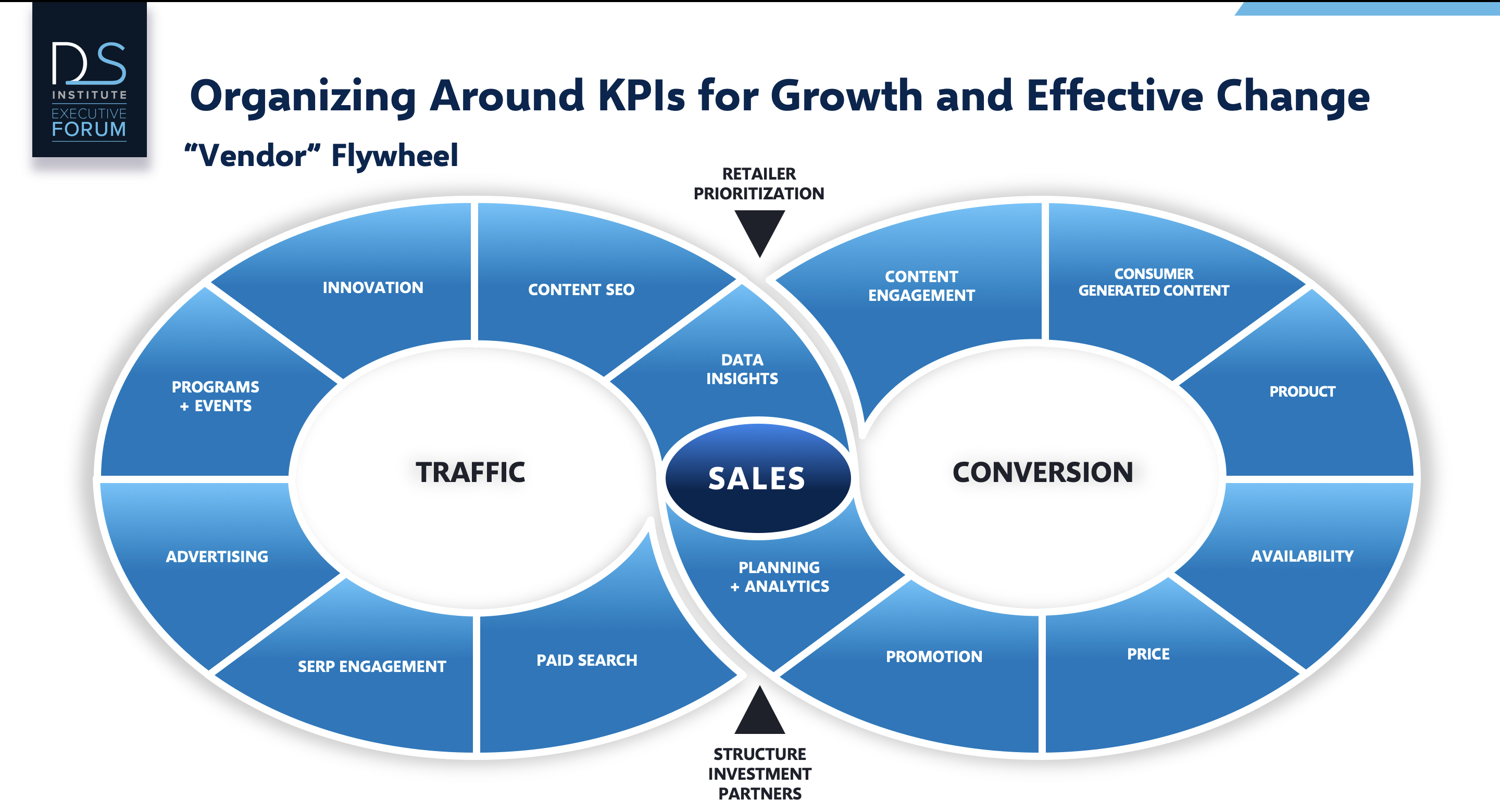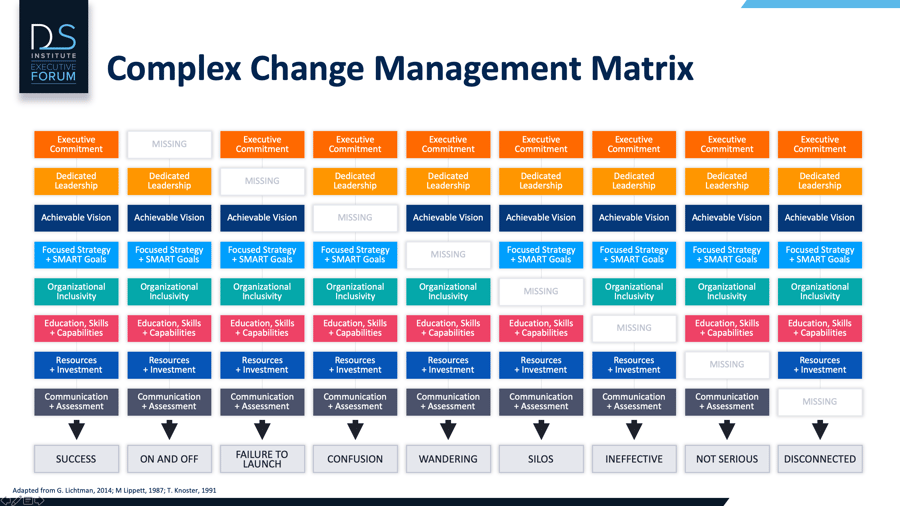x
READY TO BECOME A MEMBER?
Stay up to date on the digital shelf.
x
THANK YOU!
READY TO BECOME A MEMBER?
THANK YOU!

What does it really take to succeed — and fail — as an ecommerce organization? This is a frequent point of consideration for ecommerce executives, leading many to ask what proactive steps (and missteps) are commonly taken from an organizational perspective.
This question was posed at a recent DSI Executive Forum discussion led by ecommerce experts Chris Perry and Michael Callahan. The Digital Shelf Institute (DSI) hosts the DSI Executive Forum, an independent, invitation-only community platform for digital shelf executives at leading brands.
Perry is an expert digital strategist and former VP of ecommerce at Edge by Ascential. Callahan is the VP of ecommerce at Maytex Mills and Zenith. They outlined the common ecommerce challenges and the proactive steps successful brands take to build the perfect fire to ensure winning ecommerce business transformation.
Here are some of the essential steps that help organizations succeed, based on the DSI Executive Forum's key themes.
It's not just the pervasiveness of a digital vision that leads to success. It's the pervasiveness of common digital objectives — even for traditional functions — or having clear, shared key performance indicators (KPIs) on the digital shelf.
Ecommerce objectives should be shared across the core business team, even if it's a dotted-line scenario.
Your entire organization must be included to achieve success. You can accomplish this with learning modules, by joining cross-functional meetings, and using many other methods.
For example, if you only work with the digital Walmart team member at your organization, you're only getting 80% of the total value from the Walmart channel.
While you cannot merely point the finger at a traditional salesperson and say, "You're an ecommerce person now," you can create a path to "upskilling" for your team members. Upskilling is the process of teaching employees new skills that can help minimize skill gaps.
This could mean enabling and normalizing ecommerce store checks, not just physical store checks.
Your teams must have the capacity to accommodate different types of growth cycles and investments — not just top-down planning that only renews at the beginning of the next calendar year. Planning must also include bottom-up planning from an algorithm-driven environment, such as the digital shelf, which puts pressure on and rewards (with an increased budget) bottom-up results.

It's common to overcomplicate ecommerce KPIs with vanity metrics, forgetting about the real indicators of the business health. Your ultimate metric could include visibility, availability, conversion rate, growth, organic share rank, market share, and others.
Either way, top-line measures must be agreed upon at the executive level before allocating funds and beginning work. You can then base the release of funding and redistribution of effort on a shared understanding and definition of "ultimate success."
Develop an organization without initial commercial accountability for incubating new digital capabilities. It should be a business development venture. Decide when capabilities “graduate” from this organization into a broader organization, and deploy team members from this team inside the markets.
For every success factor, several factors get in the way of ecommerce momentum, performance, and success. Here are some of the common pitfalls, based on the DSI Executive Forum's key themes.
Ecommerce and the digital shelf start out as a pet project, with heavy leadership endorsement and enthusiasm, but as time goes on, support wanes and the next “shiny object” takes over.
Many companies line up a competing set of priorities from the same funding so that ecommerce is pitted against offline growth. This structure is the wrong move.
Ecommerce and offline commerce must be understood as part of the same multichannel ecosystem: They help one another. It's not a trade-off — it's an "and." (Analytic Partners, an analytics consulting firm expands on this concept in more detail in its latest report: "ROI Genome Report: The New Omnichannel Marketing.")
The current market is no longer an online-versus-offline world, and our organizations and KPIs must reflect this omnichannel reality.
Some leaders understand digital, and some don’t. Unfortunately, business progress reflects the capability of its leader. It’s essential to build a digital IQ — even among leadership. Reverse-mentoring can also work.
Consider your leadership: How much are they bought into the vision? How much do they understand day-to-day of what is happening in this space?
If you’re in a category where 95% of household penetration comes from brick-and-mortar sales, you may have trouble getting the kind of aggressive investment and unwavering you need to grow digital strategy.
You and your leadership will need an agreement to what share of growth or total business is required to further legitimize digital. You will also need to agree on what it will realistically take to get there.
Agree on what KPIs need to be met to prove it and what funding will be unleashed once you get there.
Many business leaders believe that ecommerce growth consists of converted offline shoppers versus expanding the omnichannel shopper.
It’s essential to have data readily available for your business to prove the accretive nature of ecommerce. Consider household level sales: How are they spending today? Where is it shifting? Check out where the existing share of your category is inside your channels versus what you have? What do you “bleed out” if you’re not present? Look at contribution to total growth as well.
Bust these myths when you see them and ask yourself what visibility of what types of data are standing in our way to getting more buy-in?
More complex and nuanced organizations tend to breed more “turf wars” even in the digital space. It’s essential to build incentives for democratizing digital knowledge and normalizing digital capabilities versus keeping them restricted to the chosen few innovators.

With the main inhibitors and accelerators laid out, Perry and Callahan have advice on how to move forward and build ecommerce business momentum:
• Diagnose: First, consider what’s missing in your organization to succeed in ecommerce.
• Identify: Next, outline the areas of the business that need to be included to succeed and incentivize normalization of digital capabilities within these functions, including sales, digital marketing, supply chain, finance, and a whole suite of other capabilities. Sales is not a full equation.
• Choose: Pick the right KPIs and understand the contributing factors that ladder up. Choose the important few that matter to you and make your flywheel — showing the relationship between leading indicators (i.e., visibility, impressions, and engagement) and ultimate measures (i.e., share and sales).
Watch our webinar on building brands and driving sales on emerging ecommerce platforms to learn more about successful ecommerce business transformation.